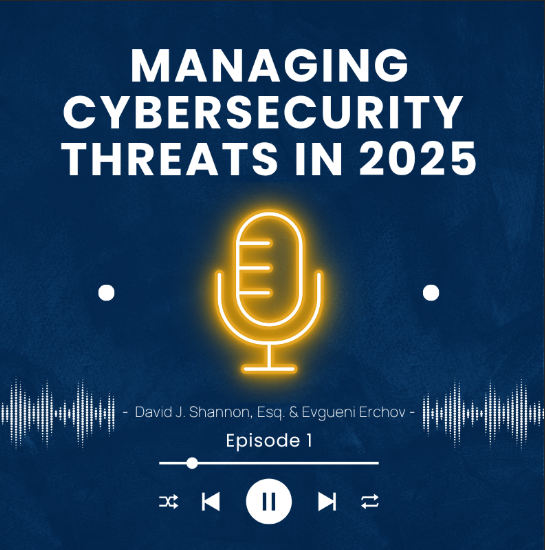December 11, 2023
ERISA Fiduciary Concerns Relating To Cybersecurity: Part I Theft Of Plan Assets

The 1920s and 1930s were infamous for bank robberies, where robbers disguised themselves as Santa Claus[i] and answered questions by stating that banks are robbed because that’s where the monies at.[ii] Fast forward about 100 years, cybercriminals do not need to disguise themselves as Santa Claus, and as to where the monies at well, U.S. retirement plan assets totaled $36.7 trillion as of the second quarter of the 2023.[iii] Since a cyber breach is not a matter of if it will occur, but a matter of when, fiduciaries of retirement plans should be addressing this risk. This blog will discuss the U.S. Department of Labor (DOL) authority over cybercrimes, litigation involving cyber theft of participants accounts, and risk mitigation techniques for plan fiduciaries.
ERISA 101
The Employee Retirement Income Security Act of 1974 (ERISA) is the statute that regulates retirement plans. Companies that sponsor retirement plans must have named fiduciaries (or appointed fiduciaries), who are persons with the discretionary authority or control over the administration or investment of a plan. Persons not named or delegated to be fiduciaries but who have this discretion may be deemed de facto fiduciaries because of their actions. Fiduciaries must carry out their obligations for the exclusive purpose of the plans participants and beneficiaries (duty of loyalty)[iv] and with the care, skill, prudence and diligence under the circumstances then prevailing that a prudent [person] acting in like capacity and familiar with such matters would use in the conduct of an enterprise of like character with like aims (duty of prudence).[v]
Moreover, fiduciaries are prohibited from engaging in certain transactions, unless an exemption applies. One prohibition includes a fiduciary not to engage a service provider for the furnishing of services to the plan.[vi] The exemption to contract with a service provider requires that: the services are necessary for the operation of the plan, the contract with the service provider is for reasonable fees, and the contract itself is reasonable as a whole.[vii] Other prohibited transactions include the fiduciaries avoiding conflicts of interest or self-dealing.[viii]
U.S. Department of Labor
The DOL has expressed grave concerns about this topic. Back in 2016, the ERISA Advisory Council issued a report recommending that the DOL publish on its website materials for plan sponsors and fiduciaries to utilize when developing a cybersecurity strategy and program.[ix] Yet, to date, no official regulations have been published by the DOL, leaving plan fiduciaries not in the dark web but in the dark.
Nonetheless the DOL has posted on its website three brochures to assist fiduciaries in meeting their responsibilities as the relate to cybersecurity.
- Tips for Hiring a Service Provider: provides certain questions plan sponsors should ask when selecting a service provider to determine if they have strong cybersecurity practices. One of them includes what type of insurance policies does the service provider have to cover losses caused by cybersecurity and identity theft breaches. The DOL also highlights the point that fiduciaries need to make sure that the service provider contract include ongoing compliance with cybersecurity and information security standards [x]
- Cybersecurity Program Best Practices: assists plan fiduciaries and record-keepers in their responsibilities to manage cybersecurity risks.[xi] The DOL here spells out in greater detail what a service provider should have such as: a formal well documented cybersecurity program, annual risk assessments, reliable annual third-party audits of security controls, and periodic cybersecurity awareness training.
- Online Security Tips: aids plan participants and beneficiaries who check their retirement accounts online to reduce the risk of fraud and loss.[xii] The DOL highlights the use of strong and unique passwords, use of multi-factor authentication, and awareness of phishing attacks.
While the brochures are considered only guidance, the DOL in its investigations have inquired into whether any of this guidance was implemented. In particular, whether their guidance has been followed in regard to hiring a service provider.
If there’s any doubt as to the DOLs jurisdiction over cybersecurity, the 7th Circuit has erased some of that doubt by finding that the DOL has broad investigative authority to investigate whether cyber breaches resulted in ERISA violations.[xiii] Relying on ERISAs duty of loyalty and duty of prudence, the 7th Circuit stated: [t]he reasonableness of [service providers] cybersecurity services, and the extent of any breaches, is relevant to determining whether ERISA has been violated either by [the service provider] itself, or by the employers that outsourced management of their ERISA plans to [the service provider].[xiv]
Thus, even without regulations in place, fiduciaries should embrace cybersecurity an issue they need to address under the duty of loyalty and duty of prudence. For starters, it would entail reviewing DOLs guidance, and when contracting with its service providers asking the questions laid out by the DOL. Other potential risk mitigating techniques involve addressing cybersecurity in the service contract itself and possibly the duty for continuously upgrading cyber protocols.
Litigation
On the litigation front, a recent lawsuit highlights the cybercrime threat. In Disberry v. Emp. Rels. Comm. of Colgate-Palmolive Co., 646 F. Supp. 3d 531 (S.D.N.Y. 2022), the participant lives in South Africa and had an account worth $750,000 in the Colgate-Palmolive 401(k) plan. The fraudster called the plans benefit hotline to update the participants contact information, intercepted various passcodes, and changed her address to Las Vegas, Nevada. The fraudster subsequently requested a distribution and wiped out the participants entire account. The participant filed a lawsuit since she wasn’t being reimbursed by the plan sponsor, recordkeeper, or custodian.
On a motion to dismiss, the court ruled as follows:
- Fiduciaries motion to dismiss was denied. The Court did find that the participants ERISA breach of fiduciary duty complaint was thin but was reluctant to dismiss the case against the fiduciaries. However, notably the court acknowledged that fiduciaries need only reasonable procedures in place, but not air-tight procedures to protect against heinous crimes like the one in this case.
- Service Provider motion to dismiss denied. The Court found the following allegations were plausible: that the service provider was a de facto fiduciary, was the only party interacting with the fraudster, and should have seen the red flags.
- Custodian motion to dismiss granted. The Court found the custodian had no discretion or control since it was a directed trustee.
This case is instructive and based on the facts of this case, an ERISA breach of fiduciary can pass the motion to dismiss stage as against the plans fiduciary and service provider for a cybercrime.
In Leventhal v. MandMarblestone Grp. LLC, No. 18-CV-2727, 2019 WL 1953247, at *1 (E.D. Pa. May 2, 2019) a participants account was also wiped out by a cybercriminal to the tune of $400,000. The cybercriminal was able to obtain a former legitimate withdrawal request, used this information, and requested withdrawals to be directed to a new bank account. This is another case where the ERISA breach of fiduciary claim survived a motion to dismiss, this time against a third-party administrator and custodian. However, note that the participants claims for breach of contract and negligence were dismissed.[xv]
What is also important about this case is that while the court found the 3rd Circuit has not ruled on this issue, it held that under traditional trust law the service provider could maintain a counterclaim against a fiduciary under ERISA for contribution and indemnity. See Leventhal v. MandMarblestone Grp. LLC, No. 18-CV-2727, 2020 WL 2745740, at *1 (E.D. Pa. May 27, 2020). The service provider alleged that the company (in this case a law firm) was the plan administrator and was careless by allowing its employees to work remotely and use their personal email accounts to conduct official business. This permitted the cybercriminal to steal the funds. The Court highlighted the split among the Circuits, where the 2nd and 7th Circuits permit co-fiduciaires to assert claims for contribution and indemnity, while the 8th and 9th Circuits hold, they do not.
Risk Mitigation
Fiduciaries are not experts in cybersecurity, nor are they law enforcement, that’s why we have the FBI and various federal agencies. Nonetheless, from the investigations by the DOL and private litigation that has ensued, fiduciaries should take actions to mitigate their risks.
First, fiduciaries should ascertain whether they are adequately insured to address a cybercrime. Note that the ERISA fidelity bond is for a theft from insiders not outside cybercriminals.[xvi] Furthermore, depending on how a case is pled, the fiduciary liability policy may or may not be triggered. Accordingly, it would be prudent to review and analyze the plans insurance coverage and determine whether to obtain a separate cyber insurance policy to provide any gaps in coverage. Also, a cyber policy can provide coverage post breach (i.e., notification expenses, fixing the inability to use or damage to networks, and data recovery costs).
Second, fiduciaries should diligently negotiate service provider contracts and be mindful of the cybersecurity. This negotiation should result in cyber related contract provisions, including provisions that provide the right to review cybersecurity audit results and demonstrating compliance. Fiduciaries should inquire if the service provider is offering a guarantee of benefits, if a participants account is hacked through no fault of their own.
In addition, fiduciaries can take the following actions:
- learn more about fiduciary responsibilities as they relate to cybersecurity;
- assess their own cyber program, in addition to that of all the service providers; and
- educate participants about cyber risks.
In conclusion, while the days of fearing bank robbers disguised as Santa Claus are long gone, a cyber threat and many of its unknown disguises remains. The DOL in investigating plans has as made it clear this is something they are looking into. The litigation landscape shows that cases survive motions dismiss. And fiduciaries, while not cyber cops, should address cybersecurity to mitigate the risks of theft of plan assets as well as claims of ERISA breach of fiduciary duty against them.
In my next ERISA cyber related article, I will cover how the fiduciary obligations play out in a theft of plan data scenario. Stay tuned.
[i] https://www.tshaonline.org/handbook/entries/santa-claus-bank-robbery (On December 23, 2927, the Santa Claus Bank Robbery was one of Texas most infamous crimes and led to the largest manhunt ever seen in the state.); see also Helms v. State, 112 Tex. Crim. 203, 205 (Tex. Crim. App. 1929).
[ii] https://www.fbi.gov/history/famous-cases/willie-sutton
[iii] See U.S. Library of Congress. Congressional Research Service. U.S. Retirement Assets: Data in Brief, Office of Congressional Information and Publishing, September 20, 2023 – https://crsreports.congress.gov/product/pdf/R/R47699
[iv] ERISA Section 404(a)(1)(A); 29 U.S.C. Section 1104(a)(1)(A).
[v] ERISA Section 404(a)(1)(B); 29 U.S.C. Section 1104(a)(1)(B).
[vi] ERISA Section 406(a)(1)(C); 29 U.S.C. Section 1106(a)(1)(C).
[vii] ERISA Section 408(b)(2); 29 U.S.C. Section 1108(b)(2).
[viii] ERISA Section 406(b); 29 U.S.C. Section 1106(b).
[ix] https://www.dol.gov/sites/dolgov/files/EBSA/about-ebsa/about-us/erisa-advisory-council/2016-cybersecurity-considerations-for-benefit-plans.pdf
[x] www.dol.gov/sites/dolgov/files/ebsa/key-topics/retirement-benefits/cybersecurity/tips-for-hiring-a-service-provider-with-strong-security-practices.pdf
[xi] www.dol.gov/sites/dolgov/files/ebsa/key-topics/retirement-benefits/cybersecurity/best-practices.pdf
[xii] www.dol.gov/sites/dolgov/files/ebsa/key-topics/retirement-benefits/cybersecurity/online-security-tips.pdf
[xiii] The DOL, through its subagency the Employee Benefits Security Administration, has investigative authority to determine whether any person has violated Title I of ERISA (the reporting and disclosure, fiduciary responsibility, vesting, minimum participation and funding provisions) or any related regulations or orders. ERISA Section 504, 29 U.S.C. 1134.
[xiv] Walsh v. Alight Sols. LLC, 44 F.4th 716, 723 (7th Cir. 2022).
[xv] The state law claims were dismissed as ERISA preemption provisions provide that: ERISA shall supersede any and all State laws insofar as they … relate to any employee benefit plan covered by the statute. Leventhal v. MandMarblestone Grp. LLC, No. 18-CV-2727, 2019 WL 1953247, at *7 (E.D. Pa. May 2, 2019).
[xvi] See Jara and Geary, Is It Time for ERISA to Be Amended to Cover Cyber Crimes, Tax Management Compensation Planning Journal, 50 CPJ 10, 10/07/2022 – https://foxrothschild.gjassets.com/content/uploads/2022/10/Jara_50_CPJ_10.pdf
Meet the Author


Fox Rothschild
Jos M. Jara is Counsel in the Employee Benefits Department of Fox Rothschild, LLP, and focuses his practice on ERISA litigation and counseling. He has defended fiduciaries and boards of directors against ERISA class action litigation alleging breach of fiduciary duty, including imprudent investments, excessive fees, and valuation issues in Employee Stock Ownership Plans. Mr. Jara’s practice also includes representing clients under investigation by the U.S. Department of Labor (DOL) regarding civil and/or criminal violations of ERISA. He was formerly a complex claims director for a major international insurance company and a senior pension law specialist with the DOLs Employee Benefits Security Administration. He is currently the Group Chair of the Employee Plans and Executive Compensation Group of the American Bar Association and a graduate of the Georgetown University Law Center.
News Type
PLUS Blog
Business Line
Cyber Liability
Contribute to
PLUS Blog
Contribute your thoughts to the PLUS Membership consisting of 45,000+ Professional Liability Practitioners.
Related Podcasts

Managing Cybersecurity Threats in 2025 Episode 1
In this engaging episode of the PLUS Podcast, our host, David Shannon,…
Related Articles

Professional Liability Market: Key Insights and Trends to Look Out For
Living in today’s progressively contentious and risk-sensitive environment, professional liability insurance takes…

Ready to Expand Your Expertise in Cyber Insurance?
The 2025 Cyber University, taking place virtually June 24th–26th, is your ideal…

Commercial Crime Insurance in Asia: Navigating Trends, Risks, and Claims Webinar Recap
On April 29th, industry professionals came together for a virtual session exploring…
